Starlink Internet for RVers is very much a reality these days, making remote workers and boondockers particularly happy. Any RVer who has ever struggled with getting sufficient internet service while traveling is about to benefit from a big change in Internet technology. It’s all due to the work of a company called SpaceX.
It’s called the Starlink Internet system.
It’s the brainchild of Elon Musk, the guy who revolutionized the automotive industry with the Tesla, and whose SpaceX rocket company has been selected by NASA to get humans on Mars.
Starlink, which recently added two new tiers of service of interest to RVers, offers the potential of solving the congested Wi-Fi and horribly slow or nonexistent Internet that so often plagues RV owners on the road and in campgrounds. Staying connected on the road is a crucial part of the RV lifestyle.
I’ve been a Starlink customer for five months now and can report that while it’s far from perfect — there are growing pains and glitches and sometimes inconsistent speeds — the system works and generally offers broadband connectivity equaling and sometimes exceeding that of 4G LTE and 5G cellular.
I can’t think of a single piece of RV industry news as significant as that.
While Starlink is a cool new solution for better, stronger Internet access for RV enthusiasts, WiFi systems and cell boosters are still a reliable and affordable way to stay connected while on the road. Having more than one way to stay connected is always a good idea, especially if one connection becomes weaker in certain areas.
Starlink’s Different Options
There are three main tiers of service:
- Residential — at $110 a month, this is the Starlink connectivity at a fixed location, most typically your house. The problem is not all areas of North America have become over-subscribed, in essence, sold out. As a result, no new users are being accepted.
- Residential with Portability — at $135 a month, this tier is for those who like to move around. Your system is registered at a permanent address but you have enabled portability, meaning you can take it with you and use it, even in over-subscribed areas. You pay month to month, even if you are not using it.
- RV — at $135 a month, this is the most recent tier and is the one that has so many RVers excited. Like portability, you can use Starlink wherever you go. The big reason to choose the RV plan is that users can stop and start service as they want. Residential users who enable portability cannot. If a residential user stops service, they have to apply all over again and find a permanent address that is not sold out.
There is also a business tier but since that applies to very few RVers, we’ll move on. Just know that the Portability and RV tiers have become available in the past several weeks (as of July 2022) and it’s likely as Starlink matures, more service options will be announced.
What Does Starlink Offer the RVer?
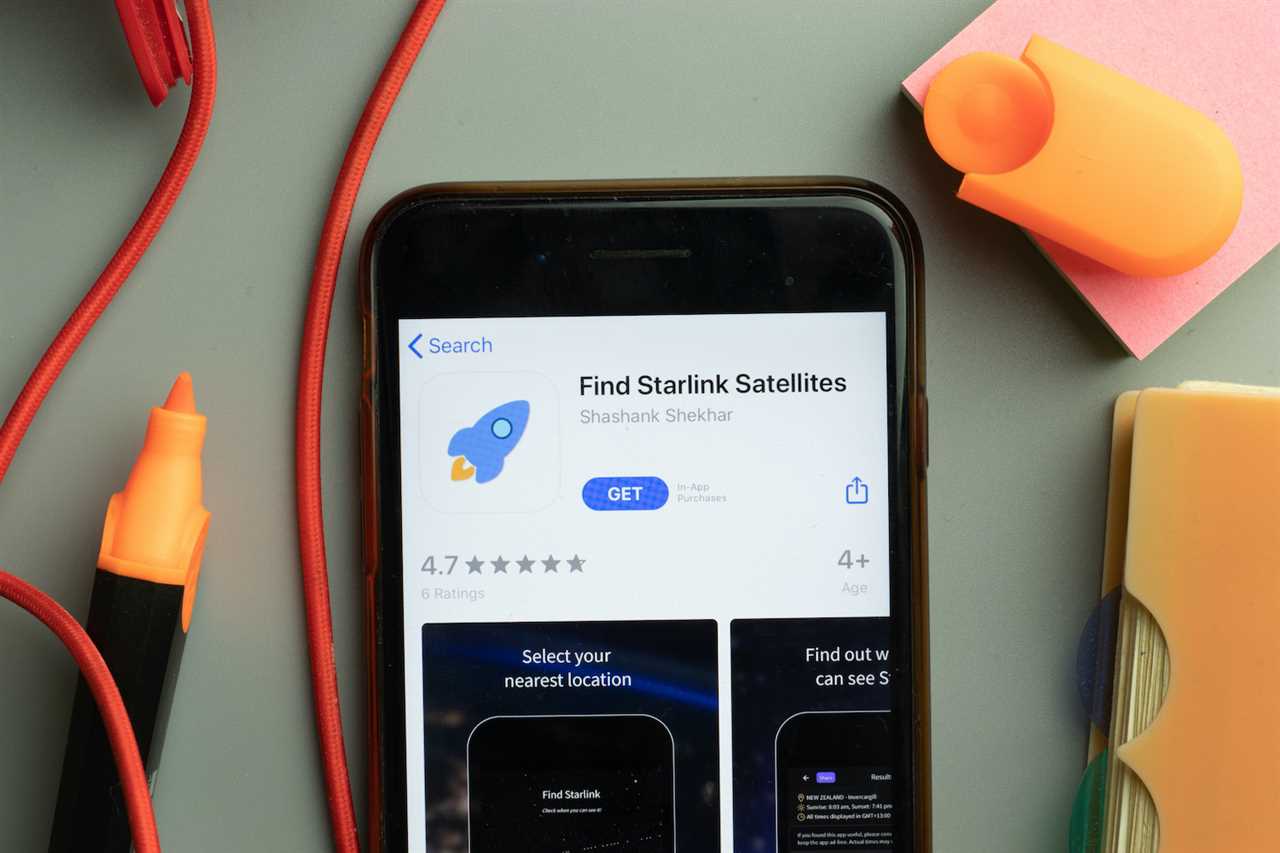
Phone screen close-up with Find Starlink Satellites mobile app logo on display. Image: Shutterstock.
Starlink has the potential of being the most dramatic improvement mobile Internet consumers have ever seen, as remarkable as when the Internet switched from dial-up to cable.
Right now, for those with Residential service, their Internet speeds regularly beat cable, leaving even 5G cellular behind. Because so many are subscribing, those home areas open to resident service are rapidly becoming sold out. To keep service stellar, Starlink is “prioritizing” access for residential users, in turn, “de-prioritizing” speeds for RV or portability customers who enter those over-subscribed home areas.
Most of those sold-out areas are in and around metropolitan areas. SpaceX has a mapping feature you can use to quickly zoom to your area to see which areas are available, on a waitlist basis (sold out), or coming soon.
RV and Residential users can, as noted, use Starlink as they camp in those sold-out areas, it’s just that they will likely experience more inconsistent access speeds.
When Will Starlink Internet for RVers Be Available?

Starlink Map
There’s no firm answer yet, but sooner, rather than later.
Actually, a lot of it is already off the ground and orbiting overhead right now, a virtual constellation of hundreds of low orbiting satellites that have been launched by SpaceX over the past two years. The satellites are connected together and beaming Internet signals to stationary users in many places.
But don’t dump your cell phone booster anytime soon. Starlink is in “Beta,” which means testing. The ground system for fixed locations is being widely tested as you read this. But it is not yet available everywhere and there are still some bugs to work out.
Full implementation for houses and some businesses will likely be in many places by the end of the year. Starlink for RVers and large trucks will follow soon behind.
Mobile Starlink for RVers Has Some Hurdles
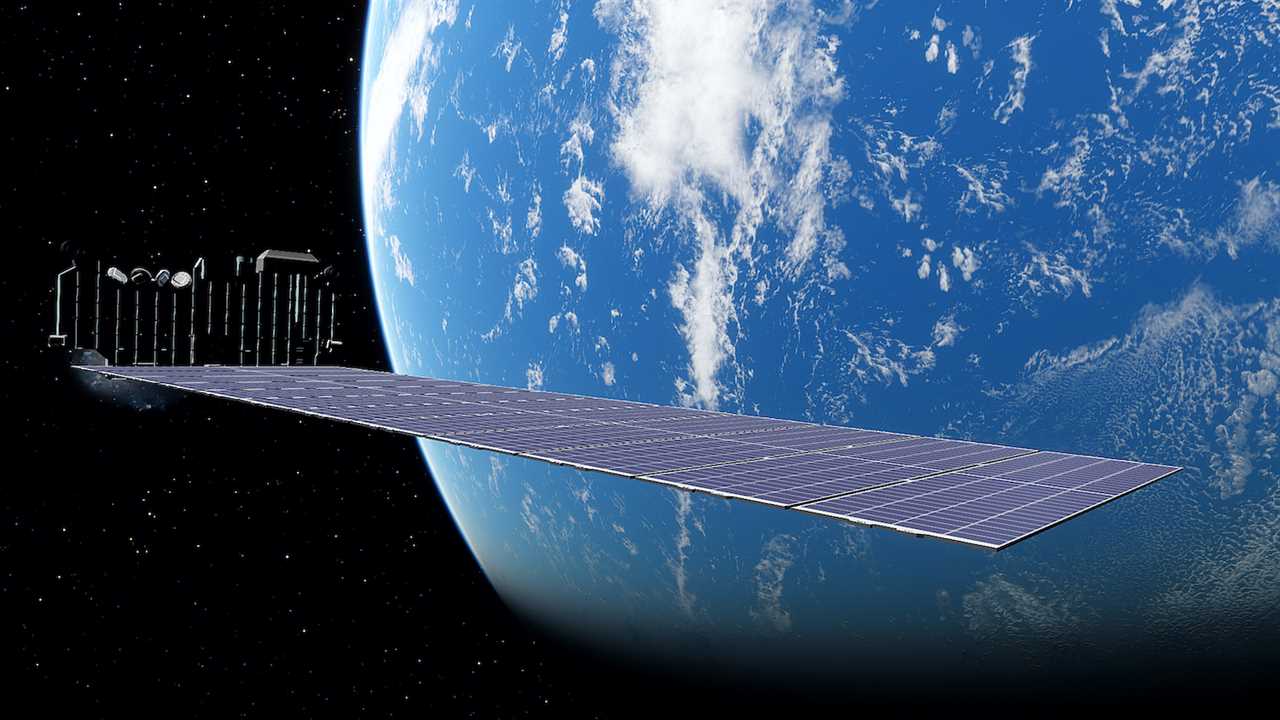
Starlink Satellite Near Earth. Image: Shutterstock.
Starlink’s low orbiting satellites are only a couple of hundred miles high as compared to the 22,000-mile high geostationary satellites we’re used to with traditional Internet and TV services. That means they are moving very fast.
So, instead of just pointing a satellite dish antenna in one spot (that’s what geostationary means), Starlink’s low earth orbits wiz past from horizon to horizon. They also cover narrower swaths of the globe.
The challenge Musk’s company faces is in developing an antenna that will track the satellites as they travel across the sky at those fast speeds. As you travel on earth in an RV or vehicle, you will go in and out of those coverage swaths, thus making it necessary for the Starlink antenna to be able to find the next Starlink satellite that covers another swath of the earth.
The Key? It’s the Antenna!
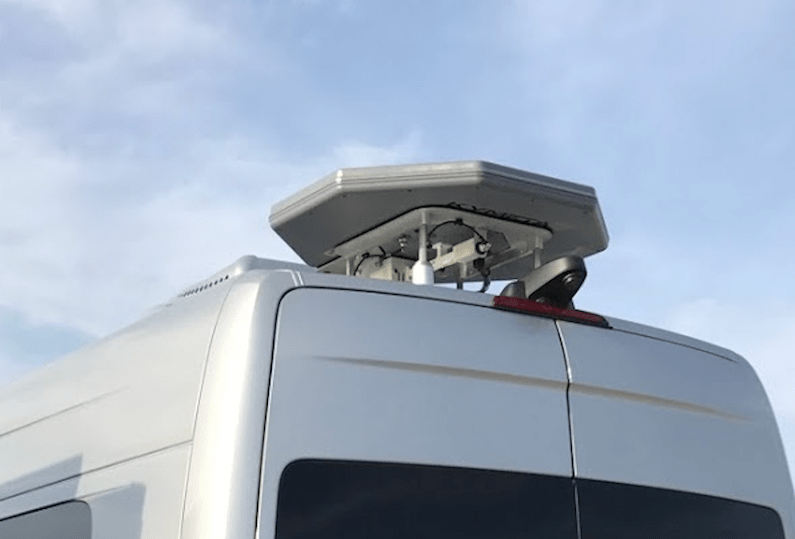
This is what a Starlink antenna may look like on an RV if it’s anything like the Bill Gates-backed Kymeta antenna I tested on my RV. Image: Mike Wendland
In truth, Musk is not the only visionary working on such an antenna. In fact, much of the antenna technology used for Starlink Internet as it pertains to RVers has already been developed.
Kymeta Corp. is the Redmond, Washington-based connectivity venture backed by Microsoft co-founder Bill Gates. A few years ago they installed, and let me test, one of their hybrid satellite-cellular mobile antennas for voice and data. It wasn’t hooked up to Starlink (SpaceX hadn’t even launched its first satellite back then), but Kymeta was clearly looking at that eventually when they hooked us up.
When Starlink Internet for RVers becomes available everywhere, it will be a variation of this style that RVers will have installed on their rigs.
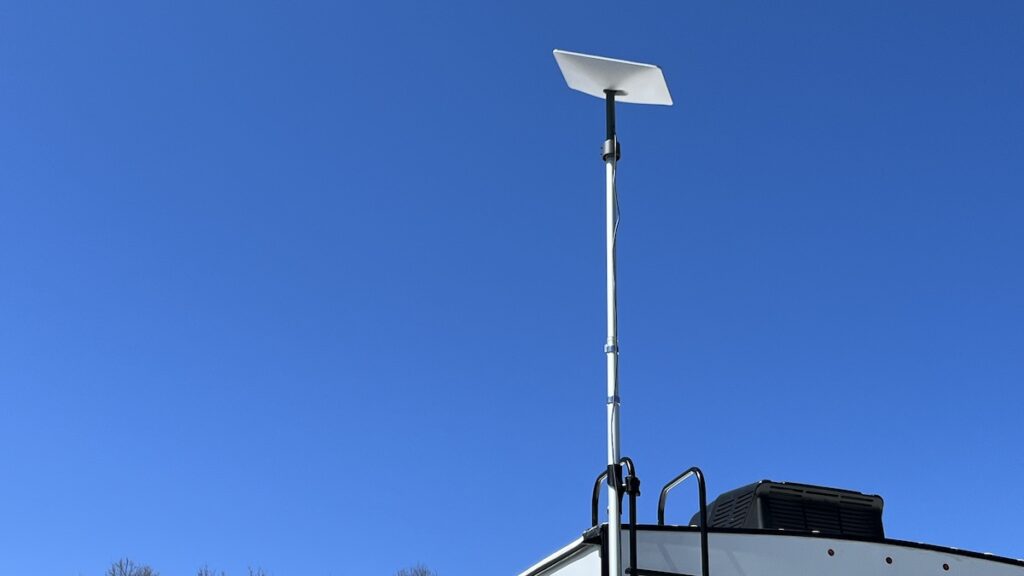
Starlink Dish. Image: Mike Wendland
In fact, a few years down the line, you’ll see these flat antennas built right into the roof of your RV or even passenger vehicles. When I tested the Kymeta dish, it was mounted on the rear of my Class B van. It kind of looked like an extra-extra-large pizza box on top of my roof.
Kymeta is currently working with several satellite companies and has not officially announced any deal with SpaceX or Starlink. But you can read between the lines. In a news release, the company says: “We’re agnostic, so we will support all of the different platforms that are out there.”
Obviously, that means they want to work with Starlink, besides the various high-altitude satellite systems it’s currently operating on across the globe.
5 Starlink Frustrations
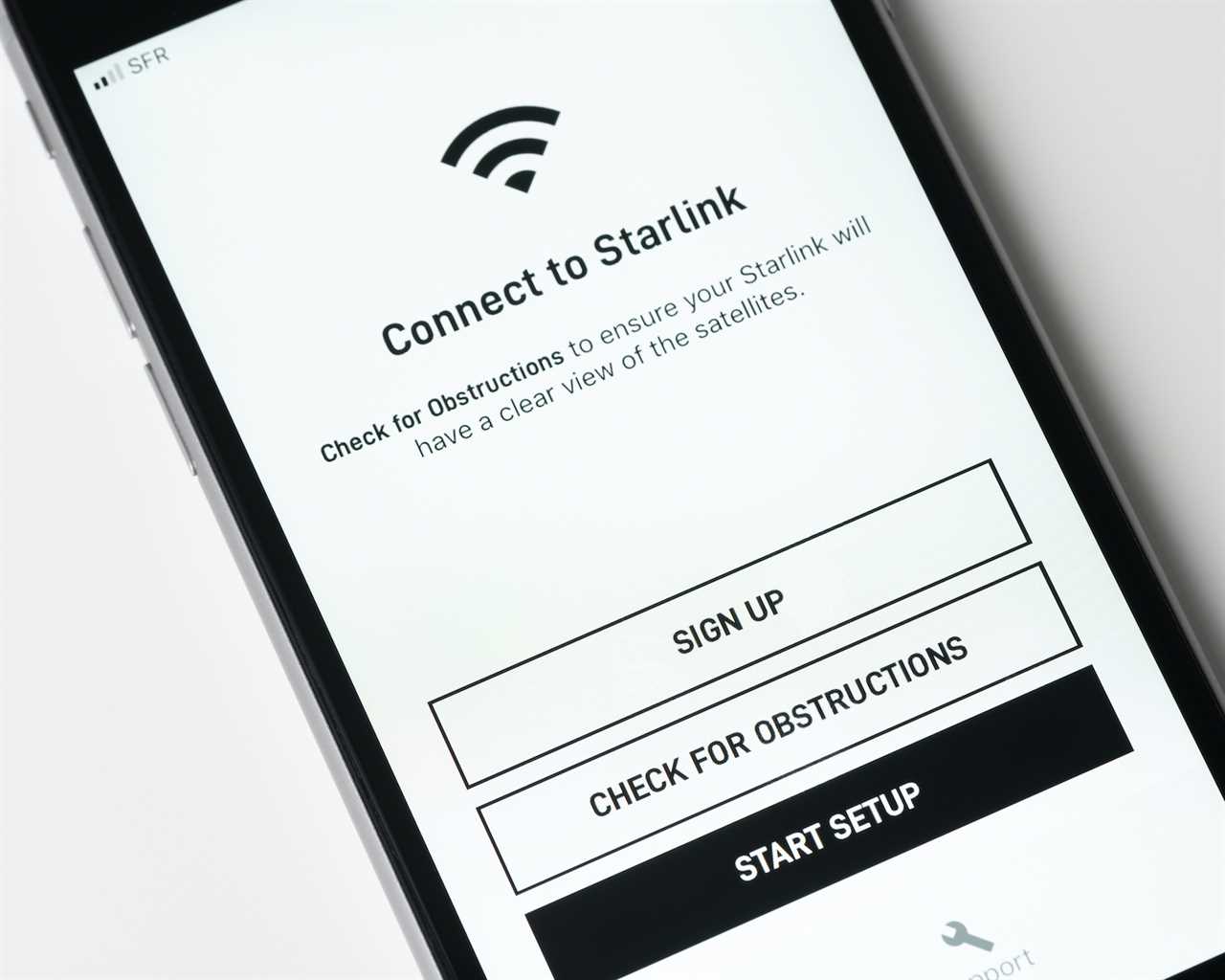
Starlink app on Apple iPhone screen. Starlink is a satellite internet constellation being constructed by SpaceX to provide satellite internet access. Image: Shutterstock.
As we’ve traveled North America in our RV these past five weeks, I’ve regularly set up my system wherever we camped. And I’ve been frustrated by the following:
- Starlink download speeds are really not that fast. Don’t get me wrong. Starlink is fast. Often broadband fast, regularly reaching speeds at well over 100 Mbps. But you know what? So does 5G cellular in many parts of the country. And those super-fast Starlink speeds have not been consistent. Depending on how oversubscribed the area may be and how congested Starlink traffic is, I have often found that cellular Internet — even 4G LTE — performs better than Starlink. Like cellular, Starlink throttles speeds (they call it “de-prioritizing”) when you are operating portable out of your registered home area.
- Starlink upload speeds are terrible. This has been my most bitter disappointment. Sometimes upload speeds reach only 1 or 2 Mbps. Rarely over 5, which is the bare minimum needed for a reliable video upload or a quality Zoom call with a good camera. Not once in our travels have I been able to get enough upload speed to do our YouTube live streams on the road with Starlink.
- Starlink doesn’t do well with trees. We love trees. We love boondocking in out-of-the-way places and forested places. Even mounted on a 20-foot pole on my RV, reliable and consistent Starlink connectivity requires a clear sky. Yes, it can connect with some trees in the field of vision of the dish. But it drops the connection every 30-40 seconds, every time the satellite its tracking is partially blocked by the trees. The drops don’t last long — another satellite is always right behind the obscured one — but the constant drops are annoying. So is always having to set up camp in a clearing, which is necessary for a solid connection.
- Starlink is not allowed for in-motion use. At least not yet. Despite those YouTube videos you’ve seen from do-it-yourself RVers who have jerry-rigged ways to anchor the antenna on the roof of the RV and get it working while in motion, Starlink says such use is prohibited and those who do so can have their access pulled. We know Starlink is working on in-motion use but big questions remain on whether a different antenna will be required and how much more such convenience will cost. So, meanwhile, it has to be set up and taken down and stowed every time you set up camp and move.
- Starlink is expensive. The gear currently costs $599. Then, whether with the portability or RV plan, it costs $135 a month. If that was for a consistently fast and reliable signal, it would be a bargain. But because it’s not reliable enough for those who must have solid Internet wherever they are, you need another system which will likely be cellular, which will cost another $135 or more per month for a decent amount of bandwidth.
Starlink’s Pleasant Surprises

Starlink Dish on Telescoping Mast. Image: Mike Wendland
You might think I’m down on Starlink. Not so!
We will definitely remain subscribers and continue to use it, especially as we boondock. That is where Starlink really shines. In places where there is absolutely zero cellular connectivity, we have been able to set up and connect every time. Because those remote locations tend to be in areas not yet over-subscribed or sold out, our connection is not de-prioritized and we have solid, fast speeds.
I am also impressed with how easy it is to set up. I bought a telescoping flagpole and a couple of brackets that fasten the pole to the rear ladder of our RV. I attach the dish to the pole and then bring the cable from the dish down to the router. Once the router is plugged in, it quickly finds and connects to the Starlink network and makes that access available as a Wi-Fi network to which we can connect all our devices.
Something else I like about Starlink? It keeps getting better. It is big and it’s growing. Starlink calls its system of satellites a constellation. SpaceX says it’s on the way to creating a “mega constellation.” As of July 2022, there are some 2,500 Starlink Internet satellites up there.
SpaceX is now launching them pretty much weekly, with about 60 new satellites being deployed with each launch. When the system is fully developed, Starlink hopes to have 30,000 of them orbiting the earth in perfectly synchronized orbits about 250 miles high, covering precise areas of geography, 24/7, 365 days a year.
Regular Satellite Internet has Improved
The satellite Internet system used by some RVers today is from Hughes and is vastly improved. It uses a satellite called Echostar and although it is still way up there in height above the earth, instead of shooting down one wide-angle beam that covers half the continent, it uses spot beam technology to send narrower more efficient signals to various parts of the earth. Some users report up to 25 Mbps speeds.
The problem is it is not widely available for mobile use and you need lots of equipment, including a big dish that must be precisely pointed in the right direction. Finding room to carry it and then setting it up and taking it down at each stop is cumbersome.
Starlink Will Be the Gold Standard for Mobile Internet

Abstract 3D rendering demonstrating satellites network around the world. Starlink satellites create Oneweb or skybridge surrounding earth. Image: Shutterstock.
When it does become widely available for mobile use among RVers, it will be screaming fast. Based on its private beta test results, it appears that under the right conditions it can deliver a satellite internet connection of 100 Mbps or more (some beta uses have reported maximum speeds of 200 Mbps at times). That is as fast – or sometimes faster – than your home cable connection.
While 5G cellular technology is technically capable of such speeds if you are right under the cell tower, it is very unreliable for on-the-move connectivity and is many years away from providing seamless nationwide coverage. Latency is not a problem with Starlink. That’s because Starlink satellites are 60 times closer to the earth than traditional Internet satellites. Starlink’s beta testing reports an extremely low latency of 20 milliseconds.
What Does SpaceX Say About Starlink Internet for RVers?
In some online conversations analyzed and tabulated by our friend Chris Dunphy from Mobile Internet Resource Center, the SpaceX/Starling people made it clear that it is coming. Here’s their statement:
Mobility options – including moving your Starlink to different service addresses (or places that don’t even have addresses!) – is coming once we can increase our coverage by launching more satellites & rolling out new software.
Did you catch the “places that don’t even have addresses” part? That’s us! RVers. We are on the move and all they need to do is launch some more satellites to provide better coverage and coordinate them all through some software. The challenge is pretty amazing. In one of the online conversations the company had with fans, I was struck by this explanation of how complicated it all is:
You should think about communication between the Starlink dish and the satellite in space as a ‘skinny beam’ between the dish and the satellite. So, as the satellite passes quickly overhead, if there is a branch or pole between the dish and satellite, you’ll usually lose connection. We’re working on some software features that are going to make this much better and, long-term, the clearance you’ll need is going to shrink as the constellation grows.
The Bottom Line on Starlink

Starlink internet could mean lightning-fast internet almost anywhere. Image: Shutterstock
At the rate Starlink is growing and improving, in two or three years, I suspect all of my above frustrations will be gone. Until then, I think of it as my backup system. For now, cellular is still my primary and most reliable Internet, but in those remote areas where we so love to go in our RV, Starlink is my ace in the hole.
I also find it much better than the Wi-Fi we get at many campgrounds and, on those occasions when we’ve found cellular networks painstakingly slow, Starlink also offers better access. So, while it isn’t quite solid enough yet to replace my cellular Internet devices, it’s only a matter of time.
If you are a full-timer or remote worker who demands Internet access everywhere, Starlink is a no-brainer. It does get through when cellular fails. If, however, you are a holiday or weekend camper and you are camping to get away from work, then stay with what you have and maybe reconsider Starlink a few months down the line. Whether you’re in a new or used motorhome, staying connected is always important.
It’s all good and getting better. Happy Trails!
Have you tried Starlink? Tell us about your experience in the comments below.
By: Mike Wendland
Title: Everything You Need to Know About Starlink Internet for RVers
Sourced From: blog.campingworld.com/the-rv-life/fulltiming/everything-you-need-to-know-about-starlink-internet-for-rvers/
Published Date: Wed, 20 Jul 2022 14:00:45 +0000
---------------------------------------------
 CampingSurvivalistHuntingFishingExploringHikingPrivacy PolicyTerms And Conditions
CampingSurvivalistHuntingFishingExploringHikingPrivacy PolicyTerms And Conditions
